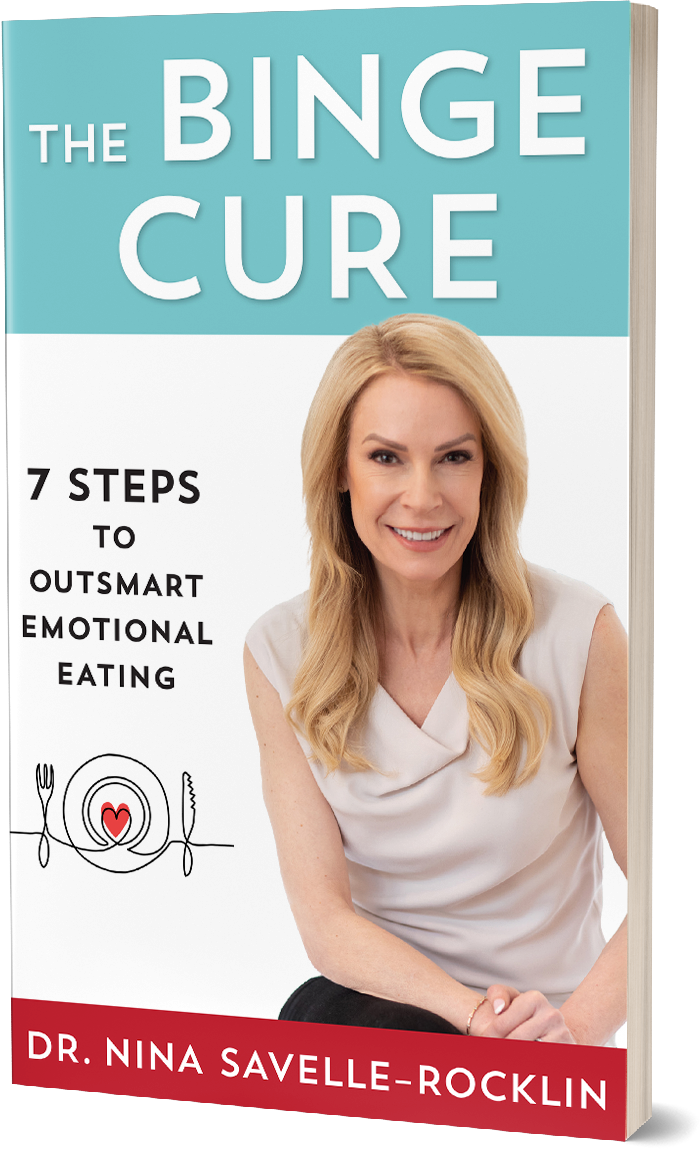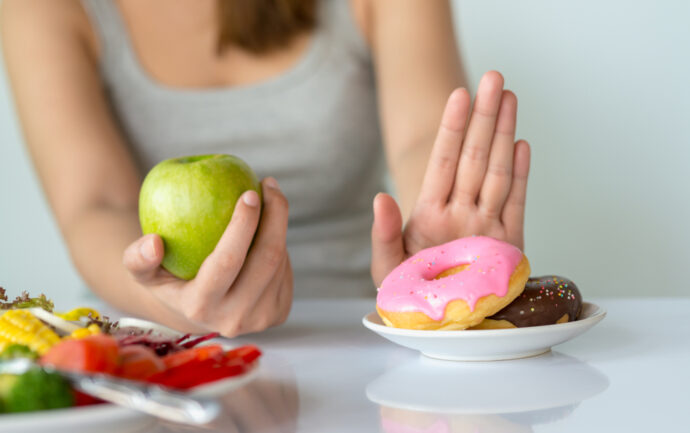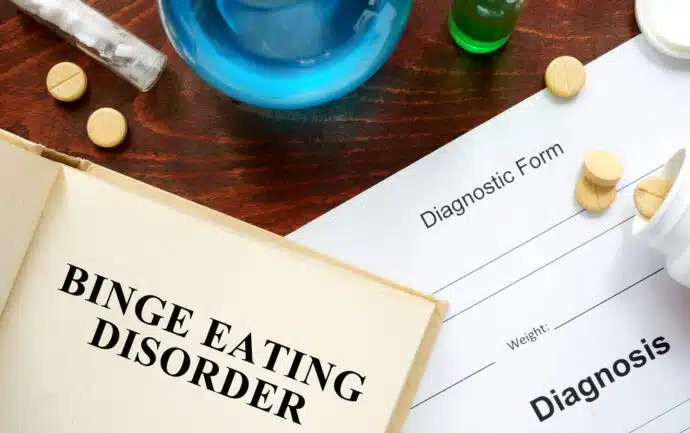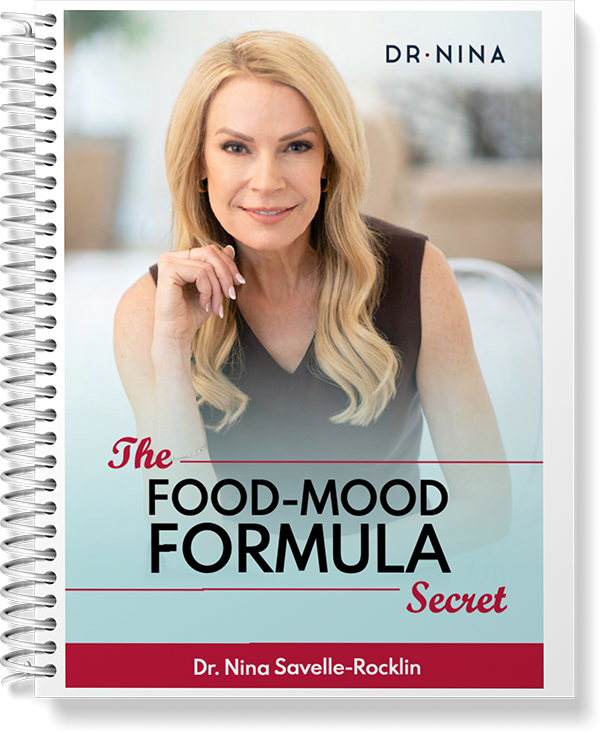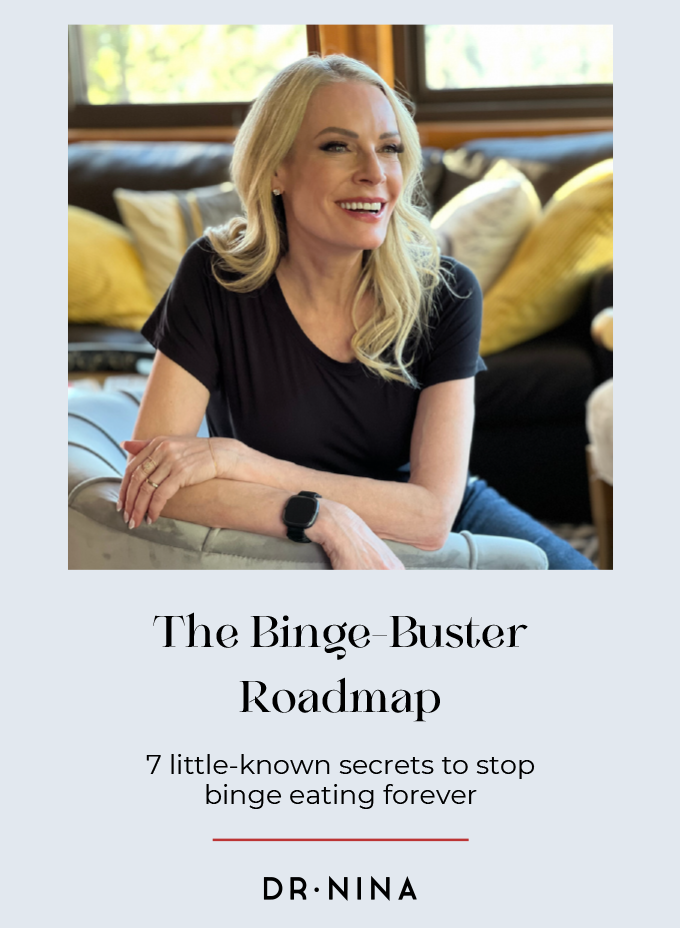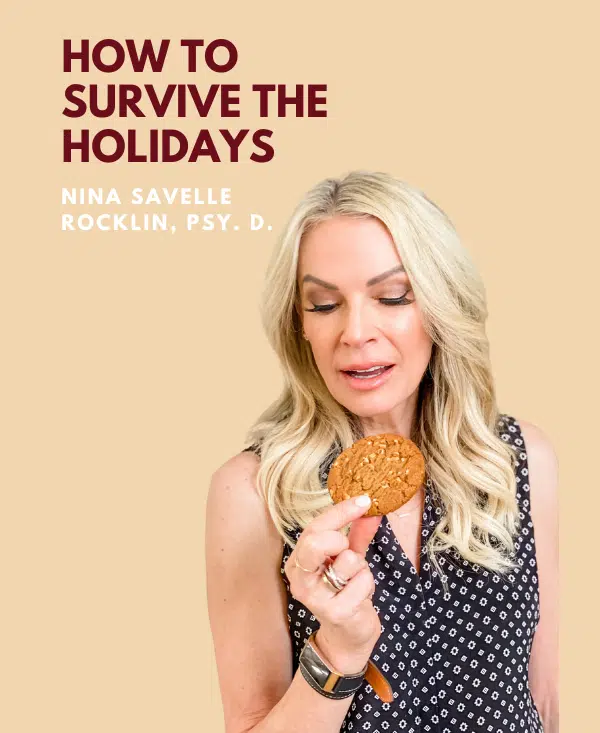Dr. Nina Savelle-Rocklin
How to Stop Emotional Eating: Master the V.A.R.Y Method for a Healthier You

Does this sound familiar to you? You get into a huge argument with your partner or are rushing to complete a very important deadline…
Before you know it, you’re grabbing that pint of ice cream or box of leftover pizza in the fridge. And before you know it, that pint of ice cream is gone. Every slice of pizza is gone and nothing is left in the box.
You’ve trashed the kitchen, and all you feel is guilt, shame, and self-loathing. If this is something that’s far too familiar with you, let me tell you now that it’s not your fault!
A lot of us turn to food when we are upset, lonely, or bored because our first experience of love, safety, and bonding is connected to being fed by our parents when we were still infants.
That’s why (and this might surprise you) food is the solution to a problem, whether that problem is a feeling that you’re uncomfortable with, or loneliness, sadness, or frustration, whatever.
Once you’re unaware of how to soothe yourself with words, you’re going to turn to food. That’s why I created a 4-word on how to stop emotional eating by soothing yourself without turning to food. It’s called the VARY method (V.A.R.Y)and it stands for Validate, Acknowledge & Reassure Yourself.
Table of Contents
- 1. Validate
- 2.) Acknowledge
- 3.) Reassure Yourself
- How to Stop Emotional Eating
- Frequently Asked Questions
1. Validate
Recognize and accept your emotions. Understand that it’s okay to feel the way you do. Strong negative emotions are a normal part of life, and there’s no reason to judge yourself harshly or critically for experiencing them.
Rather than pushing these emotions away, allow yourself to feel them, sit with them, and even express them in healthy, safe ways.
To better understand your emotions, delve into them. Explore how you feel and identify the factors influencing your emotional state. This can range from personal or work-related stress to physical stimuli like hunger or fatigue.
Acknowledging these aspects can help to diffuse the power your emotions hold over you. Naming your emotions can also act as a powerful step towards gaining self-understanding.
If you’re feeling a complex mix of feelings, try to dissect it and identify the individual emotions. Are you feeling sad? Angry? Anxious? Fearful? By pinpointing and naming each emotion, you’re reducing its power and gaining control.
In times of fraught emotions, most notably when these emotions incite a desire to reach for comfort food, it’s essential to practice self-compassion. It’s important to remember that no one is perfect, we’re all prone to making mistakes and experiencing emotional highs and lows.
Whatever you’re feeling, it’s entirely legitimate, and the best thing you can do in that moment is to offer yourself kindness and comfort – not criticism.
Finally, remember to maintain emotional balance by applying strategies with flexibility and understanding.
What works today may not be as effective tomorrow, but consistency and a willingness to adapt can guide you towards forming a healthier relationship with your emotions and their role in your eating habits.
2.) Acknowledge
Accept the truth of your feelings. Don’t deny or suppress them, but rather, let them in. One of the fundamental steps in mastering how to stop emotional eating using the V.A.R.Y Method is embedding the act of ‘Acknowledgement’.
This pivotal step largely revolves around recognizing your emotional triggers and the feelings associated with them. So, how precisely does ‘Acknowledgement’ interlink with emotional eating? Emotional eating is often a response to feelings rather than hunger.
Acknowledging these feelings and their triggers, rather than suppressing them, is a crucial step towards breaking the cycle of emotional eating. Here’s how you can proceed with ‘Acknowledgement’:
- Identify your triggers
Do you notice a pattern between certain emotions and your indulgence in comfort food? Are you eating due to stress, frustration, loneliness, or even boredom? In figuring out your trigger points, you’re already halfway through the journey of acknowledgement.
- Acknowledge your feelings
Rather than shutting these feelings off or grimacing over them, acknowledging them may seem uncomfortable yet liberating. Write them down, express them verbally, or just consciously acknowledge them in your mind. Remember, it’s perfectly fine to feel what you’re feeling.
- Understand your eating habits
Here’s where you don’t just acknowledge your feelings, but also your response to these emotions. Recognize if you’re eating for comfort rather than hunger. Are you really hungry or are you just upset?
When life throws a curveball, reaching for your favorite comfort food might seem like the most natural response. But by practicing the ‘Acknowledgement’ step of the V.A.R.Y. Method, you can begin to shift your association with food from emotional dependency towards nutrition and pleasure.
Stopping emotional eating rests significantly on acknowledging what stirs the cravings.
3.) Reassure Yourself
Encourage yourself. Remember past challenges you’ve overcome and reassure yourself that you can handle this situation, too. Keep your strengths and capabilities in mind
When we talk about the “Reassure yourself” step on how to stop emotional eating using the V.A.R.Y. Method, it sums up to giving yourself the confidence to manage emotions healthily. It’s about nurturing faith in your inherent strength that’s been overshadowed by unhealthy eating habits.
Emotions, especially intense ones, can sometimes feel as if they’re taking over your life. Emotional eating is often an attempt to deal with these feelings.
But, the ‘Reassure’ step is here to teach you, you can handle your emotions better, without the use of food as a distraction.
- Practice self-compassion: This simply means treating yourself with the same kindness, concern, and support you’d show to a good friend. It’s not about escaping but facing and accepting your feelings without judgment.
- Journaling: This is a fantastic tool for self-reassurance. Journaling your emotions helps you identify patterns in your behavior and helps release pent-up feelings.
Understanding reassurance as a critical step can effectively help with emotional eating. It’s all about reaffirming your commitment to yourself, reminding yourself of your worth, and reinforcing that you are more than capable of overcoming emotional eating.
How to Stop Emotional Eating
The V.A.R.Y method, specifically Validating, Acknowledging and Reassuring Yourself, can serve as a powerful tool on how to stop emotional eating.
The road might be challenging, but with self-awareness, a conscious effort to reframe negative self-talk, and employing other healthy emotional regulation practices such as mindfulness and relaxation, the victory over emotional eating is attainable.
Remember, seeking professional guidance can also be beneficial, as emotional regulation is a skill that can always be enhanced with professional help. Ultimately, these steps aren’t just about addressing emotional eating, but they also promote overall emotional well-being and healthier relationships.
As you embark on this journey, always remember that every step forward is a victory, no matter how small. And most importantly, remember—you are worthy, capable, and more powerful than you realize.
Frequently Asked Questions
Countless individuals grapple with understanding how to stop emotional eating, often finding themselves caught in a cycle of guilt, dissatisfaction, and confusion.
We’ve compiled some of the most frequently asked questions on this topic, shedding light on the V.A.R.Y Method and how validation, acknowledgement, and self-assurance can serve as antidotes to emotional eating.
1. What is emotional eating and how can I recognize it?
Emotional eating refers to the use of food as a coping strategy for various emotions, be it anger, loneliness, sadness, or even joy. It often occurs in the absence of actual hunger cues and can lead to guilt and other negative feelings post-consumption.
2. How can the V.A.R.Y Method assist in overcoming emotional eating?
The V.A.R.Y Method empowers you to Validate, Acknowledge, and Reassure yourself during episodes of emotional eating. It encourages self-compassion and fosters mindful eating habits over time.
3. How do I apply Validation in the context of emotional eating?
Validation is the first step of the V.A.R.Y Method. It involves legitimizing your feelings and reminding yourself that it’s okay to experience what you’re feeling. It’s about accepting your emotions without judgment or suppression.
4. How does Acknowledgment help in battling emotional eating?
Acknowledgement works closely with Validation. In this step, you’re recognizing your emotions and the fact that they’re leading to your desire to eat, without immediately attempting to change anything.
5. What is the role of Reassurance in curbing emotional eating?
Reassurance provides the soothing confirmation that uncomfortable emotions are temporary, and you have the strength to overcome them. It’s all about cultivating a loving, forgiving attitude towards yourself, assuring yourself that emotional eating is a habit you can gradually change.
Ready to transform your relationship with food?
Join Dr. Nina's newsletter and receive:
• Expert tips on overcoming emotional eating
• Strategies for sustainable weight loss
• Exclusive content not found anywhere else
Don't miss out on the latest breakthroughs in binge eating!
The Author

Dr. Nina Savelle-Rocklin is a renowned author and podcast host and one of the nation’s leading psychoanalysts known for the psychology of eating. Her signature message of, “It’s not what you’re eating, it’s what’s eating ‘at’ you” has resonated with hundreds of thousands of listeners from around the globe in 40 countries. As founder of The Binge Cure Method, she guides emotional eaters to create lasting food freedom so they can take back control of their lives and feel good in their bodies.
Related Blogs

